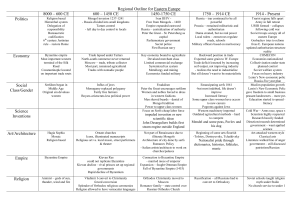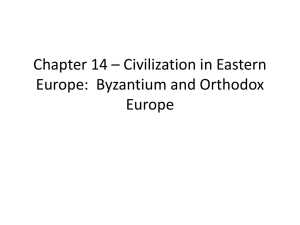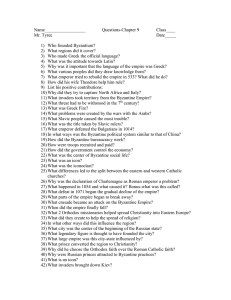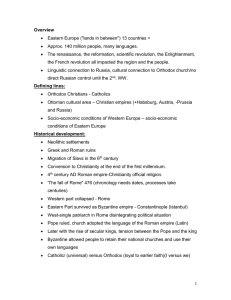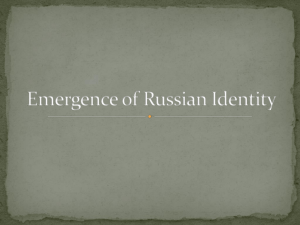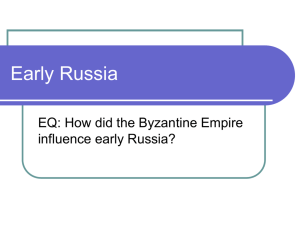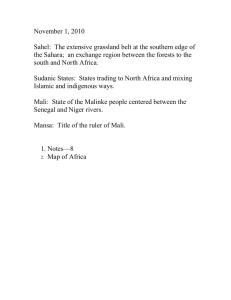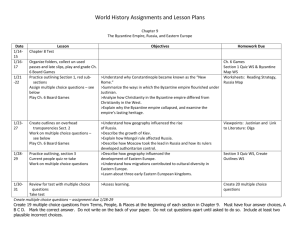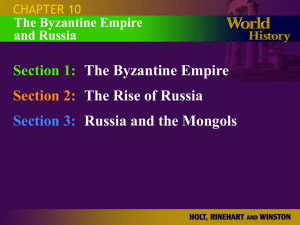East Europe Timeline
advertisement
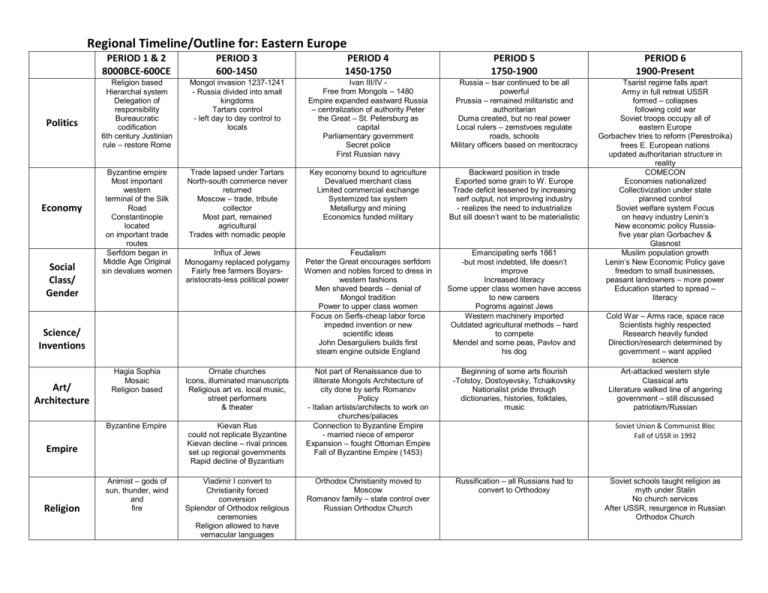
Regional Timeline/Outline for: Eastern Europe Politics Economy Social Class/ Gender PERIOD 1 & 2 8000BCE-600CE PERIOD 3 600-1450 PERIOD 4 1450-1750 PERIOD 5 1750-1900 PERIOD 6 1900-Present Religion based Hierarchal system Delegation of responsibility Bureaucratic codification 6th century Justinian rule – restore Rome Mongol invasion 1237-1241 - Russia divided into small kingdoms Tartars control - left day to day control to locals Ivan III/IV Free from Mongols – 1480 Empire expanded eastward Russia – centralization of authority Peter the Great – St. Petersburg as capital Parliamentary government Secret police First Russian navy Russia – tsar continued to be all powerful Prussia – remained militaristic and authoritarian Duma created, but no real power Local rulers – zemstvoes regulate roads, schools Military officers based on meritocracy Byzantine empire Most important western terminal of the Silk Road Constantinople located on important trade routes Serfdom began in Middle Age Original sin devalues women Trade lapsed under Tartars North-south commerce never returned Moscow – trade, tribute collector Most part, remained agricultural Trades with nomadic people Key economy bound to agriculture Devalued merchant class Limited commercial exchange Systemized tax system Metallurgy and mining Economics funded military Backward position in trade Exported some grain to W. Europe Trade deficit lessened by increasing serf output, not improving industry - realizes the need to industrialize But sill doesn’t want to be materialistic Influx of Jews Monogamy replaced polygamy Fairly free farmers Boyarsaristocrats-less political power Feudalism Peter the Great encourages serfdom Women and nobles forced to dress in western fashions Men shaved beards – denial of Mongol tradition Power to upper class women Focus on Serfs-cheap labor force impeded invention or new scientific ideas John Desarguliers builds first steam engine outside England Emancipating serfs 1861 -but most indebted, life doesn’t improve Increased literacy Some upper class women have access to new careers Pogroms against Jews Western machinery imported Outdated agricultural methods – hard to compete Mendel and some peas, Pavlov and his dog Tsarist regime falls apart Army in full retreat USSR formed – collapses following cold war Soviet troops occupy all of eastern Europe Gorbachev tries to reform (Perestroika) frees E. European nations updated authoritarian structure in reality COMECON Economies nationalized Collectivization under state planned control Soviet welfare system Focus on heavy industry Lenin’s New economic policy Russiafive year plan Gorbachev & Glasnost Muslim population growth Lenin’s New Economic Policy gave freedom to small businesses, peasant landowners – more power Education started to spread – literacy Not part of Renaissance due to illiterate Mongols Architecture of city done by serfs Romanov Policy - Italian artists/architects to work on churches/palaces Connection to Byzantine Empire - married niece of emperor Expansion – fought Ottoman Empire Fall of Byzantine Empire (1453) Beginning of some arts flourish -Tolstoy, Dostoyevsky, Tchaikovsky Nationalist pride through dictionaries, histories, folktales, music Orthodox Christianity moved to Moscow Romanov family – state control over Russian Orthodox Church Russification – all Russians had to convert to Orthodoxy Science/ Inventions Art/ Architecture Hagia Sophia Mosaic Religion based Ornate churches Icons, illuminated manuscripts Religious art vs. local music, street performers & theater Byzantine Empire Kievan Rus could not replicate Byzantine Kievan decline – rival princes set up regional governments Rapid decline of Byzantium Animist – gods of sun, thunder, wind and fire Vladimir I convert to Christianity forced conversion Splendor of Orthodox religious ceremonies Religion allowed to have vernacular languages Empire Religion Cold War – Arms race, space race Scientists highly respected Research heavily funded Direction/research determined by government – want applied science Art-attacked western style Classical arts Literature walked line of angering government – still discussed patriotism/Russian Soviet Union & Communist Bloc Fall of USSR in 1992 Soviet schools taught religion as myth under Stalin No church services After USSR, resurgence in Russian Orthodox Church
